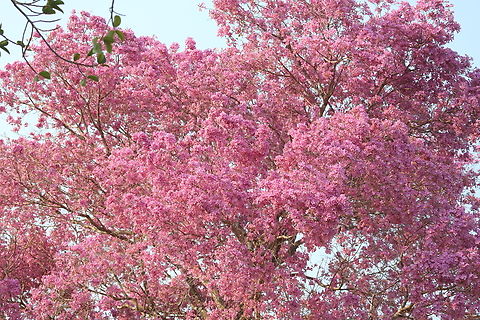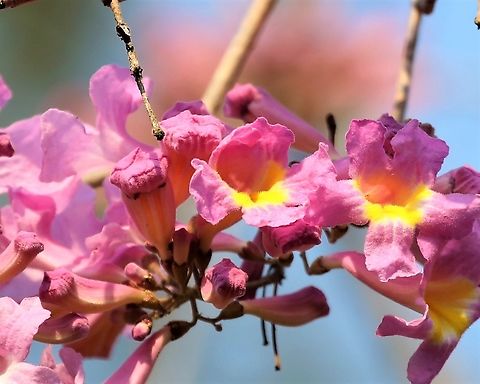
Appearance
It is a rather large deciduous tree, with trunks sometimes reaching 80 cm in width and 30 m in height. Usually a third of that height is trunk, and two thirds are its longer branches. It has a large, globous, but often sparse canopy. The tree has a slow growth rate. Leaves are opposite and petiolate, 2 to 3 inches long, elliptic and lanceolate, with lightly serrated margins and pinnate venation. The leaves are palmately compound with usually 5 leaflets.Its bark is brownish grey, tough and hard to peel. The wood is of a pleasant yellowish colour, barely knotted and very tough and heavy. It's rich in tannins and therefore very resistant to weather and sun. It is not very useful for furniture since it is so hard to work by hand. It can be found as beams or fulfilling other structural uses where needed outdoors.
In the southern hemisphere, pink lapacho flowers between July and September, before the new leaves appear. The flower is large, tubular shaped, its corolla is often pink or magenta, though exceptionally white, about 2 in long. There are four stamens and a staminode. The fruit consists of a narrow dehiscent capsule containing several winged seeds.
The flowers are easily accessible to pollinators. Some hummingbirds - e.g. black jacobin and black-throated mango - seem to prefer them over the flowers of other "Handroanthus" species, while for others like the stripe-breasted starthroat it may even be a mainstay food source.

Habitat
Harvest of wild "Handroanthus impetiginosus" for lumber to make flooring and decking has become a major cause of deforestation in the Amazon. Because the trees do not grow in concentrated stands but instead are found scattered throughout the forest, logging roads have to be built long distances to locate and harvest the trees. In most cases, once these trees are logged, the rest of the forest is cleared for agricultural use. Scientific examination of current logging practices, in which 90% of mature trees can be legally harvested, found that recovery from juvenile populations within 60 years was not likely under any feasible scenario. The parallel to the overharvesting of Swietenia macrophylla, a tree that grows in a similar distribution in the same areas as ipê, is interesting, yet ipê continues to be logged at prodigious rates with no sign of a listing in the Convention on Trade in International Species or other drastic actions likely necessary to prevent extinction. Swietenia mahagoni and Swietenia humilis were so thoroughly depleted that by the early 1900s there were essentially none left to harvest in the wild. Unfortunately the current scenario is one in which "Handroanthus" is headed for similar unsustainable depletion of wild populations.References:
Some text fragments are auto parsed from Wikipedia.